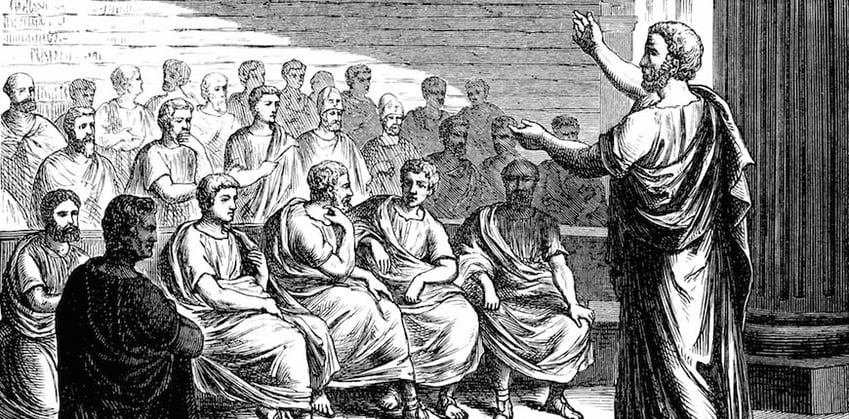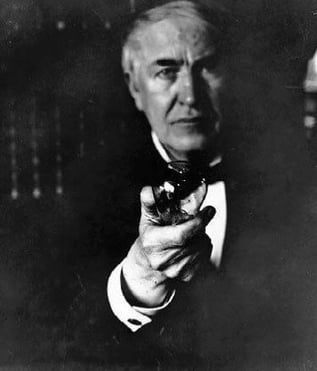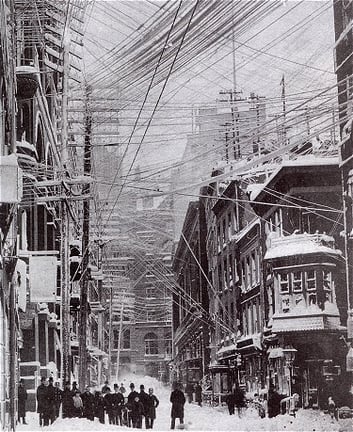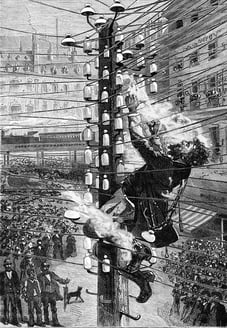

It’s often argued that marketing is the fluff of business. While that may be a fair characterization at its most drab, used deftly, marketing is capable of changing the world and shaping reality.
If you think marketing is a lot of hot air, just consider the global economy – running mostly on unbacked currencies, valued only by convention and buoyed by marketing.
Of course, the profound power wielded by marketing is not always used for good. The most obvious example of a morally bankrupt marketer is Joseph Goebbels. The man excelled at his craft, traded in the potency of a well-crafted narrative, and demonstrated a command over persuasive imagery well ahead of his time.
Still, such deviants have been omitted from this list. Not because they weren’t remarkable, but because their motives and subject matter are too abhorrent to discuss.
So without further ado, here are four of history's greatest marketers:
4. The Kardashians
When you clicked through to this article, I doubt you expected to be reading about Kim K. Still, life takes us to unexpected places and that’s part of its charm. As for the Kardashians, their charm is their brand.
If you’re wondering exactly what the Kardashians do that makes them newsworthy or famous to begin with, you’re not alone. Let me provide some background:
The late patriarch of the family, Robert Kardashian, was a successful attorney and businessman. Though divorced from matriarch, Kris, he rose to national fame for his part in assisting the defense in the OJ Simpson trial and its run-up. (The family also enjoyed national attention owing to fact that Kris remarried celebrity athlete Bruce Jenner.)
Robert’s success afforded his family a life of privilege, and his children were enrolled in Los Angeles’ premier private schools, rubbing elbows with the children of other rich and/or famous individuals.
So it happened that daughter, Kim, became friends with classmate Paris Hilton. When Paris’ star began to rise, Kim had a mind to make herself present and accounted for to whatever extent possible.
This allowed Kim to vicariously boost her own name and face recognition, while remaining close to Paris enabled her to cement herself within an elite social circle. Kim would work, play, and fraternize with celebrities.
Kim landed a job as personal stylist for Brandy, where she met and began dating the rapper Ray J. When a sex tape featuring the couple leaked on the Internet, its high profile was leveraged to land a reality TV show covering the dramas and shenanigans conjured by the Kardashian-Jenner family.

Through that platform and utilizing social media to its fullest, the family expertly managed to grow their fame and brand to gargantuan proportions. Today, the Kardashians have their name on all manner of merchandise and lifestyle products – with a combined net worth of $300 million and counting. (Making money quicker than Kanye can lose it is reason enough to merit a spot on this list.)
From food to clothing to cosmetics to video games to credit cards to books to emojis, anything remotely monetize-able has been masterfully incorporated into the Kardashian empire. Think what you will of the Kardashians, but do not doubt their marketing acumen.
Here are the 3 top takeaways from the Kardashians’ incredible marketing exploits:
1. Partnership Marketing is Among the Most Powerful Marketing Tactics
Whether is was Robert gaining fame through OJ, Kris gaining fame through Bruce, or Kim gaining fame through Paris, a well-placed friend spells incredible opportunity. The Kardashians have proven their keen awareness of this fact and aptly utilized it as the springboard of their marketing program.
This takeaway is no less applicable to other marketers than it is to the Kardashians. Everyone you meet adds to your network and stands as a potential partner.
If you’re not already in position to demonstrate your value, in most cases the network you come to bat with is your value. Each connection is a stepping stone if you approach it with the right vision and ambition.
2. Seize Every Opportunity
Without assuming the worst of anyone, I think Robert knew exactly what he was doing when he took the role of OJ’s go-to personal representative leading up to the trial and reactivating his law license to remain front and center for the trial.
Similarly, Kim inserted herself squarely within the frame of Paris Hilton mania, even though it meant occasionally being madeassuming the role of subserviant.
The most profound exemplification of this takeaway can be seen in how the family dealt with the sex tape. They adeptly turned a huge public embarrassment into an even huger opportunity that essentially represented the international launch of their brand.

As a marketer, if you’re not asking yourself a hundred times a day how different scenarios can be played to afford you or your client better exposure, you may be in the wrong line of work.
It’s not enough to be behind the door when opportunity knocks, you need to open the door with the biggest, toothiest smile you can muster and invite her in.
3. A/B Test Like Crazy and Run with the Results
It’s little secret that Kim is in many ways the lynchpin of the entire Kardashian enterprise and that her own brand is largely the product of her look and shape. (Yes, I realize that that’s objectifying and reflects poorly on our society. Alas, it’s still the truth.)
What’s interesting is that, if you wind back the tape, you’ll find that Kim discovered her signature look around 2011. Before then, her style regularly changed as she looked for that “it” factor.
She must have found it, because since then her look has increasingly embraced certain defining features, such as big, darkly shadowed eyes, highly prominent cheekbones, large lips, and callipygian curves.
Without controlling for variables and testing different propositions, as a marketer, you’re flying blind. The more experimentation you do, the more data you collect, and the more likely you are to stumble upon a winning combination of factors.
Despite what you may think, “famous for being famous” doesn’t just happen. It’s an achievement reserved only for the greatest marketers. Kudos to the Kardashians for elevating their marketing game to a historic art form.
3. Thomas Edison
 We all know Thomas Edison as America’s most prolific inventor, but how many of us know him as one of America’s greatest marketers? Probably not many. But that’s exactly what he was.
We all know Thomas Edison as America’s most prolific inventor, but how many of us know him as one of America’s greatest marketers? Probably not many. But that’s exactly what he was.
Perhaps Edison’s most widely recognized contribution to history was the first commercially viable light bulb. Less appreciated, though just as impressive, was the massive amount of innovation required of him to produce the power supplying infrastructure on which those lights relied.
Being an excellent businessman as well as scientist, Edison did not content himself with being a player in the electric company game, he endeavored to own it.
Edison realized that to achieve that goal, he would need to own the lion’s share of patents for the technological components used to generate and transmit electricity. This feat would require more than engineering genius and business prowess; it would require ferocious marketing.
Why? Because, despite the Edison Electric Light Company’s best efforts, they did not corner the market on electrical distribution. In fact, their technology was not even the best in class.
Without getting into the nitty gritty of the science involved, I’ll suffice to explain that Edison pioneered a method of electrical transmission known as direct current. Direct current was more or less a known commodity. It was tested, stable, and worked at low (read safe) voltages.
The competing technology, for which the Edison Electric Light Company owned no patents, was alternating current. Due to the particular physics involved, alternating current was a bit more complicated to effectively harness, as a result, the associated technologies were a lot less mature and less tested. AC also required higher voltages. On the plus side, AC was capable of effectively transferring electricity over much larger distances than DC. Meaning that AC allowed for fewer, larger power stations; Introducing new efficiencies of scale.
Once the Edison Electric Light Company’s main rival, George Westinghouse’s eponymous Westinghouse Electric Company bought Nikola Tesla’s patents for an effective AC induction motor and corresponding transformer power system, the stage was set for the War of the Currents.
Through the treasurer of his company, Francis S. Hastings, Edison made contact with “independent” third-party electrical engineer and activist Harold P. Brown; A man who made it his mission to bring to the nation’s attention the dangers of alternating current.

Brown wrote letters to newspapers with wild claims of AC-related deaths, distributed public service pamphlets, published research in scientific journals, testified before government officials and even performed ghoulish public demonstrations all to prove that the high voltage required of AC was fundamentally unsafe and unstable.
There was simply no realm of the public arena that did not play host to the propaganda war that Edison waged against Westinghouse.
Brown conducted his so-called research at Edison’s West Orange laboratory, received coaching on the science involved from Edison himself, and made backroom deals with the Edison Electric Light Company and Thomson-Houston (ironically, a AC proponent but vested rival of Westinghouse) to acquire Westinghouse equipment.
In late 1887, when a commission was established to find a more “humane” way to conduct prisoner executions in New York, Edison was asked what method would be best suited to the purpose. Edison’s response was short and powerful, stating "alternating machines, manufactured principally in this country by Geo. Westinghouse."
Legislation eventually passed allowing for execution by way of electrocution. When Edison was asked how that legislation might be practically implemented, he responded in a clear reference to the AC model, "Hire out your criminals as linemen to the New York electric lighting companies."
 Brown successfully campaigned to have the electric chair run on alternating current. When the chair was first used in 1890, the first jolt failed to kill the condemned William Kemmler. While, if anything, this suggested that AC was less lethal than imagined, the gruesome nature of the proceedings being associated with AC was a victory for Edison, nonetheless.
Brown successfully campaigned to have the electric chair run on alternating current. When the chair was first used in 1890, the first jolt failed to kill the condemned William Kemmler. While, if anything, this suggested that AC was less lethal than imagined, the gruesome nature of the proceedings being associated with AC was a victory for Edison, nonetheless.
Edison left any and every tactic on the table to subvert the AC model. When one line worker died from electrocution – owing more to the poorly organized and managed electrical infrastructure than anything else, it was seized as an opportunity to galvanize the public against AC.
So successful were these efforts that laws were passed to curtail AC. Most people accepted the notion that any safety concern would be resolved by moving the power lines underground. To Edison, that was too simple a solution and one that would put AC back in business in short order.
In 1889 the North American Review published an article by Edison, titled "The Dangers of Electric Lighting." In that article, Edison argued that burying high-voltage lines would only move the hazards and deaths underground. He contended that lower voltages (rendering an AC model practically useless) was the only way to make AC safe.
All of these efforts resulted in Edison successfully hamstringing AC technology, and the Westinghouse Electric Company in particular, for six years. By which point the Edison Electric Light Company, now subsumed by General Electric, itself had amassed a significant patent portfolio in the field of AC technology.
Sadly, Edison’s single-minded focus on the War of the Currents may have contributed to his fall from power in his own company, as JP Morgan and (again, ironically) Thomson-Houston orchestrated a merger that put management from Thomson-Houston at the helm of the company. Still, this is a marketing blog, and there can be no doubt that what Edison achieved from a marketing perspective was astounding.
Here are the 3 top takeaways from Edison’s incredible marketing exploits:
1. Find Proxies to Carry Your Marketing Message
The same statement or view coming from one person can elicit a radically different response than if it came from another. This is something that Edison understood well.
He bolstered Brown from a distance so that he could carry the message of the Edison Electric Light Company with perceived objectivity. Why? Because third-party advocacy works.
That’s why endorsements are a thing and why companies invest massive amounts of money in programs designed to engender brand ambassadors. Edison was a century ahead of his time in realizing the power of a marketing proxy and playing it to perfection.
2. Seek Out Creative Platforms to Engage Your Audience
At it’s core, Edison’s claim was a scientific one. He maintained that an electric power infrastructure running direct current would be safer and better performing than one running alternating current.
As a matter of science, you might have expected the debate to play out in academia. Well, it did. But not there alone. It also played out in the press, in public squares, in the inner chambers of government, and in prisoner executions.
You might object to such methods – you probably should – but you cannot deny their persuasive appeal. Every time the DC onslaught against AC would grow stale in a given arena, the battle would be waged anew in an entirely different space.
In truth it's a testament to Edison's relentlessness in all he did. Never afraid of experimentation, he would invent the box, and then think outside of it. In his efforts to extract what he wanted from reality, he would combine different disciplines and techniques in ways previously unimagined.
Of course, not every attempt worked, but when they did, they were impressive and effective in part because of how novel and unexpected they were. Forcing the Battle of Currents upon the national conversation through the prism of capital punishment is one such example.
(An interesting aside: Edison was actually opposed to the death penalty. Was it coincidence that the Kemmler incident played out to dually advance his interests? I'm not sure, but I'm inclined to believe that it was the marketing mechanations of a peerless master.)
This indefatigable spirit, and creative tinkerer's mentality, was famously expressed by Edison when he said, "I haven't failed, I've just found 10,000 ways that won't work." Today, the best marketers strive for a similar sort of all-enchroaching brand engagement.
Successfully inserting your messaging in places where it's not a natural fit is a telltale sign of great marketing. Connecting to audiences through multiple platforms and across multiple spaces is an easy thing to see and appreciate after the fact. The difficult part is thinking up a way to do it before it’s ever been done.

It was this creative and engaging “everywhere marketing” that kept the Edison Electric Light Company perched firmly atop the electric power industry, despite what is today generally accepted to have been inferior technology.
3. Have an Open Relationship with Logic and Emotions
When the logic and science didn’t support Edison’s claim he did not hesitate to invoke emotions and sensationalism. At one point, Brown challenges Westinghouse to an electrocution duel. In increasing voltages, the two would trade shocks – Brown receiving direct current while Westinghouse would receive alternating current.
Of course, Westinghouse refused the challenge since he knew that in similar voltages, deliberate electrocution from the competing models was about equally deadly. It therefore stood to reason that he had a 50% chance of dying or quitting before Brown. No one would accept those odds and Brown/Edison knew that.
Consider for a moment then the brilliance of issuing such a challenge. To the logical observer, it reveals little. To the rest of us human people, it represents Westinghouse’s capitulation to the inferiority of his own technology.
This was Edison’s superior mind applied to marketing and this is why, to begin with, he chose safety as the focus of his assault on AC. Scare tactics appeal to emotion and Edison knew his way around emotions better than most.
When physically burying AC lines presented an easy solution to public safety concerns, Edison went right back to his bread and butter, ignoring reason, and simply trying to scare the s&!t out of people.
Edison was a man of reason, no doubt, but he was also a master of emotion. This is how he managed to make lemonade out of the lemons he was given with the botched Kemmler execution. The story didn’t read how Edison wanted it to, but he had the good sense to realize that the picture sure did!
History rightly remembers Edison for his accomplishments as an inventor. As a marketer, I can’t argue with that. I can however note that the success of a superior invention need not rely on marketing excellence.
It’s the success of an inferior product that speaks to marketing magic. In the case of Edison, he marketed his superior and inferior technological innovations so that they were indistinguishable in their own time – adding a fascinating wrinkle to an already storied legacy.
This is the first of a two-part series, exploring history’s best, most seldom appreciated marketers. For Part II, click here.
---------

by The Penguin Team on February 24, 2016
As a leading B2B digital marketing agency, We help B2B Technology Companies, enterprise software, and hardware companies increase brand awareness, reach more qualified leads and close more customers. Penguin Strategies is a Diamond Partner of HubSpot.






